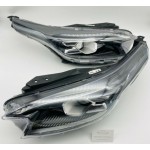
It is the law in the UK for all cars over three years old to pass an annual MOT test, unless they are vintage vehicles manufactured before 1960. The MOT is designed to make sure the car is safe and roadworthy, and will not be prone to accident or breakdown. Many cars fail MOTs for simple and easily avoidable reasons. Here are some of the most common.
1. Lights and signalling
Nearly one fifth of cars fail an MOT because of a problem with the lights. This could simply be a blown bulb which needs replacing, so it’s worth switching on all the lights an inspecting your car before you take it to the garage. Check the indicators flash properly, and ask someone to stand behind the car and watch for the light while you press the brake pedal.
Inspect the headlights for their overall condition: have the lenses become misty, or are there any chips or cracks in them? It is possible to clean out headlights with a special kit. Damaged lights can be replaced with good quality second hand spares, or new ones which match the manufacturer’s specifications.
2. Suspension
More than one in 10 MOT failures are caused by suspension issues, according to the RAC. The suspension can be damaged by hitting potholes or speed bumps too fast, or overloading the car. Sometimes, it is not as obvious as you may think when the suspension is damaged.
Listen out for odd clunking noises when you are driving and cornering, and check to see if the car appears level when stationary. If it is sitting too high or low at one corner, it may have a damaged spring.
3. Brakes
One in 10 cars fail the MOT because of issues with the brakes. For obvious reasons, this part of the car needs to be kept in good working order! The brake pads and discs may have become worn down, which you may be able to inspect yourself if you know how to remove a car wheel.
Other signs of faulty brakes include squealing or grinding noises when you apply the brake pedal, and the vehicle pulling to one side when coming to a stop.
4. Tyres
The legal minimum tread for tyres is 1.6mm across the central three quarters. A good tip for quickly checking the depth of the tread is to insert a 20p coin between the tyre ridges. If you can see the outer border of the coin, then the tread is too low, and you are driving with unsafe tyres.
Also check the tyres for other issues, such as cracks and bulges, which could lead to punctures or blowouts.
5. Issues affecting the driver’s view of the road
It is vital to have an uninterrupted view of the road when driving, but alarmingly, some people drive with satnavs, air fresheners, or even soft toys obscuring their vision! Also check for any chips and cracks in the windscreen which are in the driver’s eyeline. Also make sure the wipers work correctly, and the bonnet is securely latched.
If you are looking for an Audi A3 front bumper, visit our website today.





























Leave a Comment